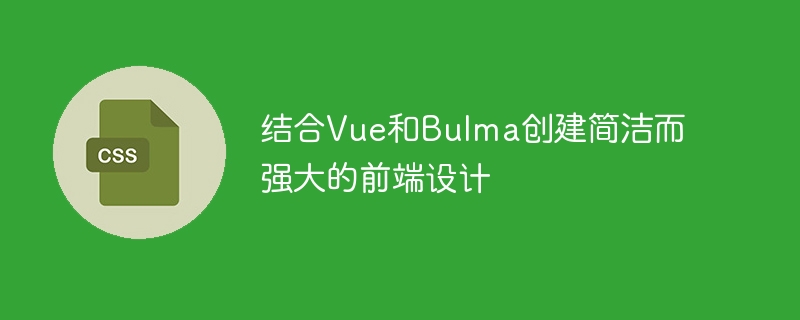Home >Web Front-end >CSS Tutorial >Build powerful yet simple front-end user interfaces using Vue and Bulma
Build powerful yet simple front-end user interfaces using Vue and Bulma
- WBOYWBOYWBOYWBOYWBOYWBOYWBOYWBOYWBOYWBOYWBOYWBOYWBOriginal
- 2023-12-27 09:44:431307browse

With the rapid development of the Internet and mobile applications, the importance of front-end development is increasingly valued by people. In order to achieve the beauty and functionality of web pages, developers continue to explore new tools and frameworks. In this article, I will introduce how to combine Vue and Bulma to create a simple and powerful front-end design.
Vue is a progressive framework for building user interfaces. It's easy to learn and use while offering high performance and flexibility. It provides good code reusability through componentization, allowing developers to develop and maintain code more efficiently.
Bulma is a modern CSS framework based on Flexbox. It provides a large number of styles and components, including grid systems, buttons, forms, navigation, and more. Bulma's design is simple and powerful, allowing developers to quickly build beautiful interfaces.
First, we need to install Vue and Bulma. Run the following command in the command line:
npm install vue npm install bulma
After the installation is complete, we can start writing code. First, we need to create a Vue instance and import Bulma’s style file. Add the following code in the HTML file:
<!DOCTYPE html>
<html>
<head>
<link rel="stylesheet" href="node_modules/bulma/css/bulma.min.css">
</head>
<body>
<div id="app">
<!-- 在这里写你的Vue组件 -->
</div>
<script src="https://cdn.jsdelivr.net/npm/vue"></script>
<script>
var app = new Vue({
el: '#app',
// 在这里写你的Vue组件
});
</script>
</body>
</html>Next, we can start writing Vue components. In the Vue instance, we can define a data object through the data attribute to store our data.
var app = new Vue({
el: '#app',
data: {
message: 'Hello World!'
},
});Now, in our HTML file, we can use {{ message }} to display data. For example:
<div id="app">
<p>{{ message }}</p>
</div>Next, we can start using Bulma components to beautify our interface. In Vue components, we can use Bulma's classes to set styles. For example, we can use the button class to create a button:
<button class="button is-primary">Click Me</button>
Even, we can combine Vue's data binding to dynamically change the style of the button:
<button class="button" :class="{'is-primary': isActive, 'is-danger': !isActive}" @click="toggleButton">
{{ buttonMessage }}
</button>var app = new Vue({
el: '#app',
data: {
isActive: false,
buttonMessage: 'Click Me'
},
methods: {
toggleButton: function() {
this.isActive = !this.isActive;
this.buttonMessage = this.isActive ? 'Active' : 'Inactive';
}
}
}); Above In the code, we use :class to bind the style class, and @click to bind the click event. When the button is clicked, the toggleButton method will be triggered, thereby changing the button's style and text.
In addition to buttons, Bulma also provides a wealth of other components, such as forms, navigation, grid systems, and more. Developers can choose and use these components according to their needs.
To sum up, combining Vue and Bulma can create a simple and powerful front-end design. Vue provides good componentization and data binding mechanisms, while Bulma provides rich styles and components. Developers can quickly build beautiful and feature-rich front-end interfaces through these two frameworks. I hope this article is helpful to you, and I wish you greater success in your front-end development!
The above is the detailed content of Build powerful yet simple front-end user interfaces using Vue and Bulma. For more information, please follow other related articles on the PHP Chinese website!

